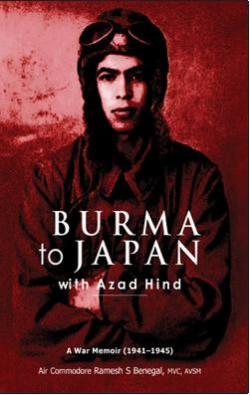Burma to Japan with Azad Hind: A war memoir (1941-5)

By (Air Commodore) Ramesh Benegal, Lancer Publishing, New Delhi, 2009, 165 pages including index, ISBN: 10: 1-93551-11-9, £15.99
Review by Ian Nish
Ramesh Benegal (1926-2003) was born in Rangoon, Burma, to an Indian family. When Rangoon was bombed by the Japanese, he was evacuated at the age of 15 with his mother in the hope of reaching India by an overland route. This proving impossible, he returned to Rangoon. Ramesh became infused with aspirations for Indian independence and felt that the Japanese could help in achieving this. He registered at a Japanese language school and joined the Indian National Army (INA) [also known as Azad Hind Fauj – Azad Hind means Free India]. Impressed by Japan’s airpower, he volunteered for training in her airforce. He was invited to dinner by Subhas Chandra Bose [popularly known as Netaji – respected leader], the head of the INA [and one of the most prominent leaders of the Indian independence movement], at his official Rangoon residence and was selected for training in Japan.
In his autobiography, Benegal gives a horrifying account of the journey he had to make. Starting from Moulmein in southern Burma, he travelled uncomfortably through the jungles of Burma and Thailand by the ‘Death Railway’ to Bangkok. Revived by hospitable treatment there, his party proceeded by train to Singapore where they were given instruction for three months. While some deserted the programme at this stage, Ramesh pressed on, inspired by the personality of Bose whom he met again in Singapore.
The dilapidated vessel on which he travelled, the Ural-maru, was torpedoed and sank in the South China Seas. He was rescued and boarded an oil tanker. It was also torpedoed and the small party of cadets landed in the Philippines where they were left to their own devices so far as food and lodgings were concerned. Enterprisingly, they made their way to Manila where they were sustained by members of the resident Indian community. After a stay at Clark airbase, they eventually flew to Japan and took up their first assignment at the Koado Gakuin (or preparatory school) in Tokyo. By a coincidence, Netaji Bose happened to be visiting Japan in November 1944 for the anniversary of the Great East Asian conference of 1943 and took time to give the trainees an inspirational address.
In the following month the cadets moved on to the Imperial Japanese Air Force Academy (空軍士官学校). They were naturally vulnerable to the US intense bombing campaigns on Tokyo which began when their course had only lasted three months. When Japan surrendered on 14 August, the Academy was closed and no provision was made for the foreign cadets. Their dilemma was compounded when their sponsor and protector, Subhas [Netaji] Bose, died from injuries sustained in an air crash in Taiwan on 18 August. In great distress, Benegal moved to the house of A M Sahay, a prominent Indian resident in Tokyo, to await his fate.
The American authorities at the outset of the occupation of Japan did not know how to handle these Indian nationals and treated them as part of the victorious Allies. It was only when Colonel John Figges, the British representative, took over that they were taken to a repatriation centre and sent out of the country on a US Air Force Skymaster. After some harrowing misadventures, they were incarcerated in Stanley Jail in Hong Kong. They joined a repatriation ship which called at Shanghai, Manila and Singapore before reaching Indian soil at Madras. With some difficulty Ramesh was reunited with his family. In an attempt to forge a new life, he took an engineering degree and joined Air India. He enlisted in the Indian Air Force in 1950 and rose to the rank of air commodore, acquiring the decoration of Maha Vir Chakra (MVC) in 1972.
The second world war gave rise to many accounts of bizarre personal experiences. Benegal’s is the story of his nightmarish sufferings as a teenager and his achievements in later life. But the book illustrates also the national policies of Japan, India and Britain. The Japanese were generous in taking him on for training – a sort of ‘technological transfer’ before its time – but, because of wartime difficulties at the front and in Japan, they were not able to treat him with the care which one might have expected towards a citizen of the Co-prosperity Sphere. The Indian expatriate communities throughout the east were divided in their attitudes to the war, some wanting a quiet life and others more inclined to take sides. They stood behind Ramesh at critical points in his odyssey. The British only come into his story after 1945: but the account given is an unhappy record of misunderstandings. Ramesh is very critical of the Allies generally and their use of the bombs at Hiroshima and Nagasaki in particular.
This book along with my other review (Historical Dreadnoughts: Marder, Roskill and the Battles for Naval History) have a bearing on Anglo-Japanese relations in a time of crisis. They offer an unusual slant on the Asia-Pacific War which throws new light on some aspects of the conventional accounts of that war.

